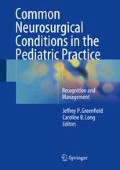Abstract
Seizures in children are challenging to both diagnose and treat. The first and most important step is to distinguish abnormal movements in children as seizures from the myriad of benign movements that children can exhibit. The second step is to distinguish whether the seizures are generalized or focal. Generalized seizures start in bilateral cerebral hemispheres and include multiple different types of seizures from nonconvulsive, i.e., absence, to convulsive, i.e., generalized tonic-clonic seizures (GTCs). Focal seizures originate in a particular region of the brain and have different manifestations depending on what part of the brain is activated. Any individual having more than one unprovoked seizure over a 24-h period is classified as having epilepsy.
The evaluation of a patient presenting with a first time seizure differs if the seizure is febrile or nonfebrile. In children with febrile seizures, it is essential to rule out intracranial infection, but otherwise, these seizures are relatively benign and have a low chance of leading to epilepsy. Afebrile seizures require a more detailed evaluation for the underlying epilepsy syndrome or acute intracranial pathology. An electroencephalogram (EEG) is critical to classify seizure type and epilepsy syndrome. Neuroimaging may be required to evaluate for intracerebral pathology.
The treatment of a prolonged seizure is standard; however, the treatment of different forms of epilepsy is individualized, tailored to both seizure type and side effect profile. In medication resistant seizures, diet and surgery are excellent options.
Access this chapter
Tax calculation will be finalised at checkout
Purchases are for personal use only
References
Subcommittee on febrile seizures. Febrile seizures: guideline for the neurodiagnostic evaluation of a simple febrile seizure. Pediatrics. 2011;127:389–94.
Paolicchi J. Epilepsy. In: Lynn E, Newton H, Rae-Grant A, editors. The 5 minute neurology consult. Philadelphia, PA: Lippincott Williams & Wilkins; 2004. p. 186–97.
Hirtz D, et al. Practice parameter: evaluating a first nonfebrile seizure in children: report of the quality standards subcommittee of the American academy of neurology, the child neurology society and the American epilepsy society. Neurology. 2000;55:616–23.
Hausr W. The prevalence and incidence of convulsive disorders in children. Epilepsia. 1994;35(2):S1–6.
Riviello JJ, et al. Practice parameter: diagnostic assessment of the child with status epilepticus (an evidence-based review): report of the Quality Standards Subcommittee of the American Academy of Neurology and the Practice Committee of the Child Neurology Society. Neurology. 2006;67:1542–50.
Vendrame M, et al. Localization of pediatric seizure semiology. Clin Neurophysiol. 2011;122:1924–8.
So E. Value and limitations in seizure semiology in localizing seizure onset. J Clin Neurophysiol. 2006;23:353–7.
Thammongkol S, et al. Efficacy of the ketogenic diet. Which epilepsies respond? Epilepsia. 2012;53:55–9.
Kossoff E, et al. Optimal clinical management of children receiving the ketogenic diet: recommendations of the international ketogenic diet study group. Epilepsia. 2009;50:304–17.
Lerner JT, et al. Assessment and surgical outcomes for mild type I and severe type II cortical dysplasia: a critical review and the UCLA experience. Epilepsia. 2009;50:1310–35.
Paolicchi JM, et al. Predictors of outcome in pediatric epilepsy surgery. Neurology. 2000;54:642–7.
Author information
Authors and Affiliations
Corresponding author
Editor information
Editors and Affiliations
Rights and permissions
Copyright information
© 2017 Springer Science+Business Media New York
About this chapter
Cite this chapter
May, A.S., Paolicchi, J.M. (2017). Pediatric Seizures. In: Greenfield, J., Long, C. (eds) Common Neurosurgical Conditions in the Pediatric Practice. Springer, New York, NY. https://doi.org/10.1007/978-1-4939-3807-0_24
Download citation
DOI: https://doi.org/10.1007/978-1-4939-3807-0_24
Published:
Publisher Name: Springer, New York, NY
Print ISBN: 978-1-4939-3805-6
Online ISBN: 978-1-4939-3807-0
eBook Packages: MedicineMedicine (R0)

